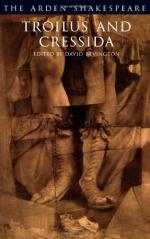|
This section contains 5,458 words (approx. 19 pages at 300 words per page) |

|
SOURCE: "Rhetoric and Action in Troilus and Cressida," in CLA Journal, Vol. XXXV, No. 1, September, 1991, pp. 93-108.
In the following essay, Loggins asserts that the complex, conflicting structure of Troilus and Cressida is related to the fulfillment of personal needs and interests through open, state-sanctioned violence.
In Troilus and Cressida, as in Henry IV, 1, Hamlet, and King Lear, the movement is to violence. The action in Henry IV, 1, moves to the duel between Hal (or Harry) and Hotspur, with which Harry regains his lost office as the Prince of Wales. The action in Hamlet moves to the duel between Hamlet and Laertes, with which Hamlet fulfills his father's charge. The action in King Lear moves to the duel between Edgar and Edmund with which Edgar redeems himself and becomes the new Gloucester.1 In other words, each of these plays moves to violent action where major characters—Hal, Hamlet...
|
This section contains 5,458 words (approx. 19 pages at 300 words per page) |

|


